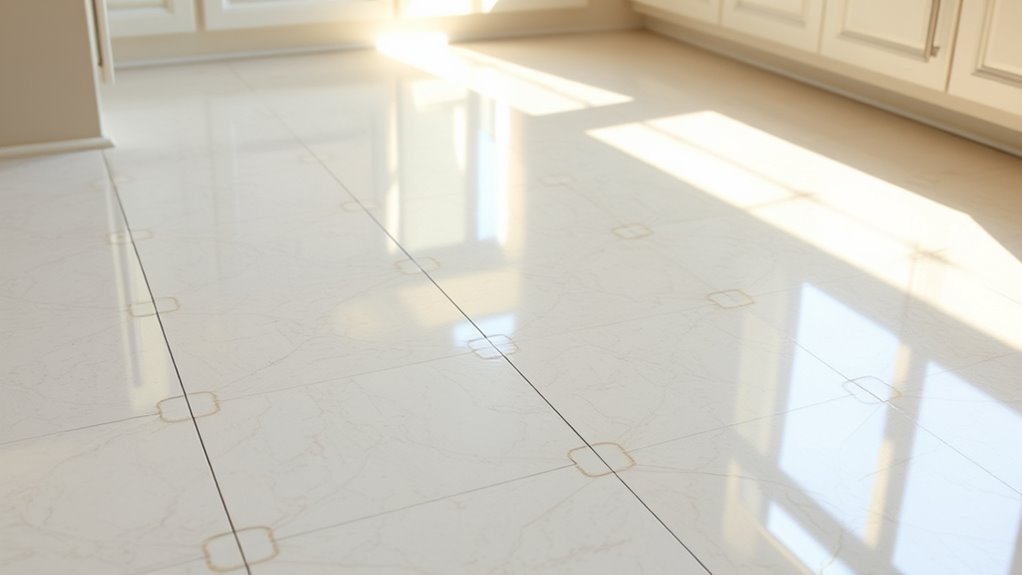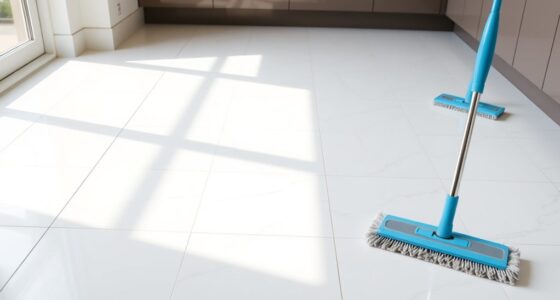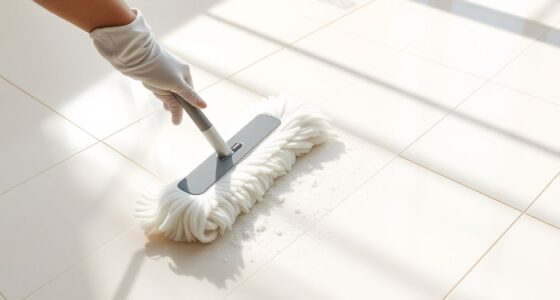To deep-clean tile floors without damage, start by sweeping or vacuuming to remove loose dirt and prevent scratches. Mix warm water with a mild, pH-neutral cleaner and gently scrub the tiles and grout with a soft brush. Rinse thoroughly and apply a grout sealer to protect against stains and moisture. Finish by drying and polishing the surface. Following these steps carefully helps keep your floors clean and damage-free; keep going to discover more helpful tips.
Key Takeaways
- Sweep or vacuum thoroughly to remove loose debris and prevent scratching before deep cleaning.
- Use warm water with a pH-neutral cleaner or specialized tile solution to avoid damaging tiles and grout.
- Apply grout cleaner or baking soda paste, then gently scrub grout lines with a small brush for stain removal.
- Seal grout after cleaning with a high-quality sealer, and allow it to cure fully before walking on the surface.
- Dry tiles completely with a soft cloth and polish to restore shine and maintain a damage-free, pristine appearance.

Have you ever wondered how to restore your tile floors to their original shine? The secret lies in a thorough, careful cleaning process that targets dirt, grime, and stains without causing damage. Start by sweeping or vacuuming the entire area to remove loose debris. This step prevents scratching during the scrubbing process and ensures you’re not just pushing dirt around. Once the surface is clear, prepare a cleaning solution suitable for your tiles. A mixture of warm water and a mild, pH-neutral cleaner works well, but you can also use a specialized tile cleaner for tougher stains. Avoid harsh chemicals that could erode grout or dull the tile’s finish.
Start your tile cleaning by sweeping or vacuuming to remove loose debris and prevent scratches.
Next, focus on grout sealing and stain removal. Grout often traps dirt and stains, making your floors look dull. To effectively remove stains and prepare the grout for sealing, apply a grout cleaner or a paste made from baking soda and water. Use a small brush to scrub the grout lines gently. This not only lifts stubborn stains but also helps in sealing the grout afterward, which prevents future staining and makes cleaning easier. Once you’ve scrubbed the grout, rinse the area thoroughly with clean water to wash away loosened dirt and cleaner residue. For stubborn stains, repeat this process or consider using a steam cleaner designed for tile and grout. Steam cleaning penetrates deep into the grout, loosening dirt without harsh scrubbing, and is gentle enough to avoid damaging your tiles. Incorporating a high-quality cleaning tool can also improve results and efficiency.
After cleaning and removing stains, it’s time to seal the grout. Grout sealing is essential because it creates a protective barrier that repels stains and moisture, keeping your floors looking fresh longer. Apply a high-quality grout sealer with a brush or spray, following the manufacturer’s instructions. Allow it to cure fully before walking on the tiles. Sealing the grout not only prolongs the cleanliness but also reduces the frequency of deep cleanings needed. Once sealed, dry the tiles thoroughly with a clean cloth to prevent water spots and streaks.
Finally, polish your tiles with a soft cloth or mop to bring back their shine. Regular maintenance, coupled with periodic grout sealing and stain removal, keeps your tile floors looking pristine. Remember, the key to a deep clean without damage is patience and the right tools. By addressing grout sealing and stain removal carefully, you ensure your floors stay beautiful and durable for years to come.
Frequently Asked Questions
How Often Should I Deep-Clean My Tile Floors?
You should deep-clean your tile floors every 6 to 12 months to keep them looking their best. Regular cleaning helps remove dirt and grime, but occasional deep cleaning, combined with applying floor polish and sealant, protects the surface. After deep cleaning, consider resealing and applying a fresh coat of floor polish to enhance durability, prevent staining, and maintain a shiny appearance. This routine keeps your tile floors in top condition.
Can I Use Vinegar on All Tile Types?
You can’t use vinegar on all tile types because vinegar safety varies with tile material compatibility. For glazed ceramic or porcelain tiles, vinegar is usually safe and effective. However, if you have natural stone tiles like marble or travertine, vinegar can damage the surface. Always check your tile’s manufacturer recommendations first. When in doubt, test a small area and opt for a pH-neutral cleaner to protect your floors.
What Are Signs My Grout Needs Professional Cleaning?
You’ll notice your grout needs professional cleaning when it becomes visibly stained or discolored, making DIY grout sealing less effective. If your grout color restoration efforts don’t bring back its original look or if mold and mildew persist despite regular cleaning, it’s time to call in pros. They can deep-clean, restore grout color, and make certain a lasting seal, saving you effort and preventing damage over time.
Is Steam Cleaning Safe for Delicate Tiles?
Steam cleaning can be safe for delicate tiles if you use the right settings and equipment designed for gentle cleaning. You should always prioritize delicate tile care by avoiding excessive heat and pressure that might cause damage. Test a small, inconspicuous area first, and keep the steam moving to prevent moisture from seeping into grout or under tiles. When done carefully, steam cleaning effectively refreshes your floors without risking harm.
How Do I Prevent Future Staining After Cleaning?
To prevent future staining, you should focus on stain prevention and sealing techniques. After cleaning, apply a high-quality sealant to create a protective barrier against spills and dirt. Regularly reseal your tiles, especially in high-traffic areas, to maintain protection. Wipe up spills immediately and use mats or rugs in vulnerable spots. These steps help keep your tile floors looking pristine and stain-free over time.
Conclusion
Now that you know how to deep-clean your tile floors without causing damage, you’ll find it’s like giving your home a fresh start. Imagine your floors as a canvas—regular cleaning is the brush, but deep cleaning is the bold splash of color that revives the entire space. With these steps, you’ll keep your floors sparkling and protected, turning everyday chores into a satisfying renewal. Ready to make your tiles shine like new? You’ve got this!









